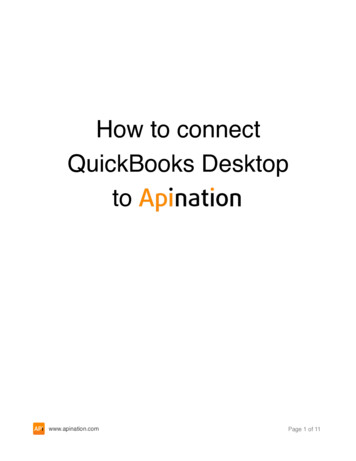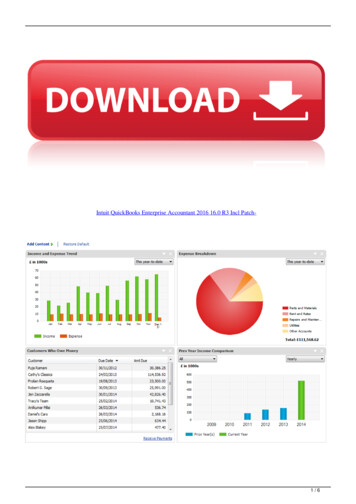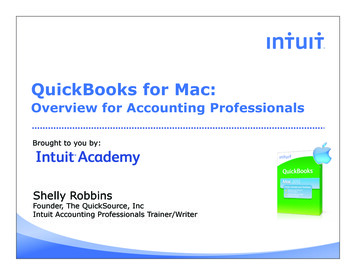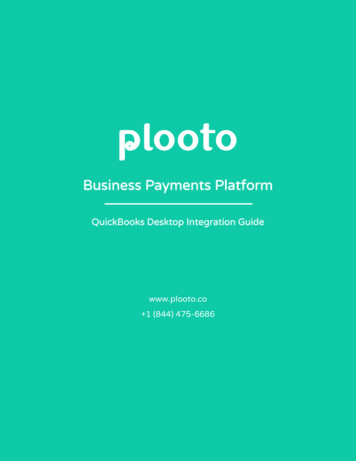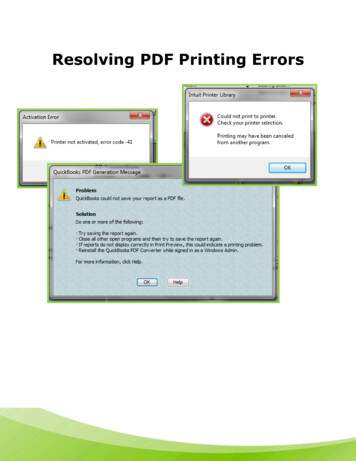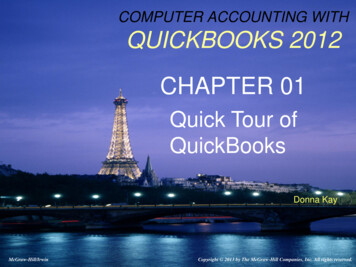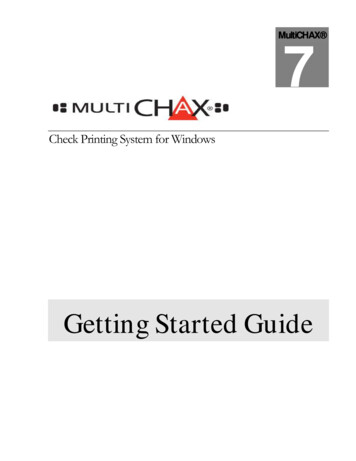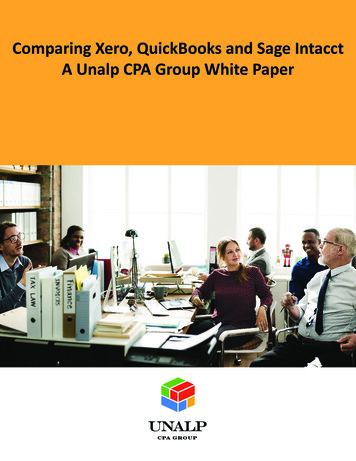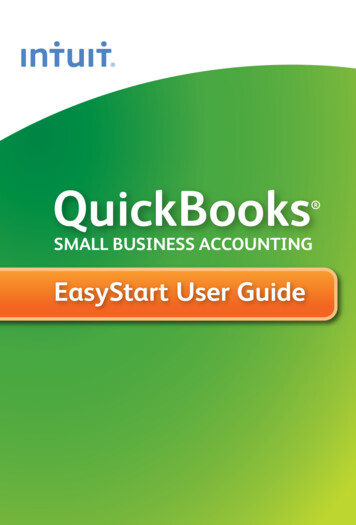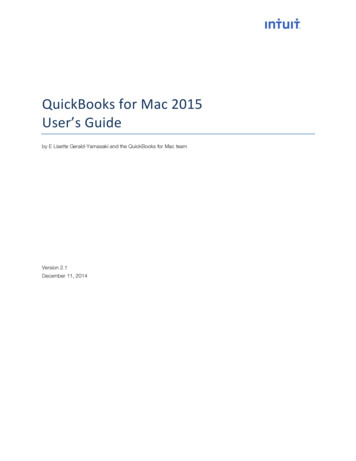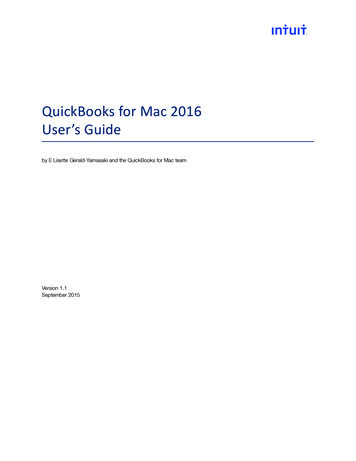
Transcription
QuickBooks for Mac 2016User’s Guideby E Lisette Gerald-Yamasaki and the QuickBooks for Mac teamVersion 1.1September 2015
AcknowledgementsNo single person can write a guide of this size and scope. I’d like to thank the other members of the QuickBooks forMac team, including Lisa-Anne Chung and Liz Hamill, and especially Brooks Bell and Devon Hubbard. Also, this bookis a generation of other guides that came before it. I’m very grateful for those guides. A super-special thank-you toShelly King, without whom this guide would not exist.Copyright and trademarksCopyright 2015 Intuit Inc. All rights reserved.No part of this publication may be reproduced in any form or by any means, without prior written permission ofIntuit Inc., with the following exceptions: Any person is hereby authorized to store documentation on a singlecomputer or device for personal use only, and to print copies of documentation for personal use, provided that thedocumentation contains Intuit’s copyright notice.Unauthorized reproduction is a violation of applicable laws. Intuit, the Intuit logo, QuickBooks, Quicken, andTurboTax, among others, are registered trademarks and/or registered service marks of Intuit Inc. Other parties’marks are the property of their respective owners.Various QuickBooks products and services are protected by pending patents and by one or more of the followingU.S. Patents: 5134564, 5423033, 5649115, 5842185, 5903881 and 6446048.TrademarksIntuit, the Intuit logo, QuickBooks, Intuit Online Payroll, Quicken, QuickBase, TurboTax, EasyStep, and QuickZoom,among others, are registered trademarks and/or registered service marks of Intuit Inc. in the United States andother countries. Mac, the Mac logo, and the “Built for Mac OS X” logo are registered trademarks of Apple Computer,Inc., used under license. Aatrix is a registered trademark of Aatrix Software, Inc. Adobe and Acrobat are registeredtrademarks of Adobe Systems Incorporated in the United States and/or other countries. American Express is aregistered trademark of the American Express Company. LightSpeed is a registered trademark of Xsilva Systems,Inc. Other parties’ marks are the property of their respective owners and should be treated as such. This programuses the following open source components under their respective licenses: Blast.c, Boost, Excelsior! and SQLite.Portions of these components are the copyrighted material of their respective authors.QBM UG 2016 (1509-4)2QuickBooks for Mac 2016 User’s Guide
ContentsCHAPTER 1 Welcome to QuickBooksfor Mac 2016 1Running QuickBooks2System requirements2Integration / compatibility requirements2Installing and Upgrading QuickBooks 2Converting your file from QuickBooks forWindows3What’s New in 2016?3New to QuickBooks?4Creating company file4Next steps6Set Up and Go7Importing customers, vendors, andemployees10Before you start11To import your contacts11Troubleshooting11Entering historical transactions12Why enter my historical transactions?12Do I wait to enter current transactionsuntil I get the historical data in?13Order matters13Entering vendor transactions13Entering customer transactions15Entering bank and credit cardtransactions17Switching from Windows?19QuickBooks Windows vs. Mac: What’s thedifference?19Converting your file from Windows 20What is and isn’t converted when youswitch to QuickBooks for Mac21Exchanging your file with your accountant25Using QuickBooks in multiuser mode26Setting up multiuser27Step One: Buy and install additional userseats27Step Two: Install QuickBooks Server27Step Three: Create user accounts 27Step Four: Start multiuser mode28QuickBooks Server28Where to store your file29QuickBooks for Mac 2016 User’s GuideOther things to know about multiusermode29CHAPTER 2 Lists31How to use lists32Classes list33Employees list33Other names list34Customer and Vendor Profile lists35Terms for payment36Payment methods37Other things you can do with lists38Merging list entries38Exporting names for mail merge39Inactive list entries39Deleting an item from a list40Adding what’s important to you withCustom Fields40Adding custom fields41Tips and tricks: Quick Add and Setup 42CHAPTER 3 Accounts44Types of accountsBalance sheet accountsIncome and expense accountsYour Chart of AccountsAdding or editing accountsAdding subaccountsDeleting an accountNumbering your accountsCombining two accountsWorking with registersOpening a registerEditing a transaction in a registerEntering split transactionsChanging an opening balanceChanging an account’s colorMoving a transaction to a differentaccountUsing a general journal4444454546485050515253535455555656CHAPTER 4 Items 60Types of items61Adding or editing items62Creating service, non-inventory part, orother charge items63Creating items for inventory64i
Creating subtotal itemsCreating group itemsCreating discount itemsCreating payment itemsCreating tax itemsImporting items in batchesOther things to know about itemsChanging the price of itemsCreating subitems656566676869707071CHAPTER 5 Getting paid 72Customer Center72How do I use it?73Tips and Tricks74Adding or editing a customer75Address pane76Additional Info pane76Payment info (if you use MerchantServices)77Notes78Contact Sync78How do I use it?78Managing syncing80Want to know more?80Setting up jobs81Types of Jobs82Creating jobs for a customer82Tracking items ordered especially for a job83Paying subcontractors83Tracking services performed by an owneror partner84Estimating work you’re going to do85Getting paid for work you’ve done87Sending your customer an invoice87Invoicing a customer over time (progressinvoicing)89Modifying your progress invoice90Invoicing groups of customers91Creating a group for batch invoicing91Sales: Batch invoicing92Statement charges93Entering Statement Charges94Creating Statements95Setting up for automatic charge entry96Memorizing charges for new customers97iiCorrecting overcharges on statements97Correcting undercharges on statements98Including reimbursable expenses on astatement99Applying a discount to a statementcharge100Marking a sale as pending100When a customer pays you101Giving your customers sales receipts101Receiving payments104Accepting your customer’s credit anddebit cards106What you should know beforeprocessing a credit card payment inQuickBooks106Processing credit and debit cards FAQ107Entering your customer’s credit/debitcard information108Voiding a credit card transaction 108Tracking GoPayment and other creditcard transactions in QuickBooks 109Handling down payments andoverpayments109Applying a discount for early payment110When you’ve applied payment to thewrong invoice110Setting up for finance charges111Assessing finance charges111Using Intuit PaymentNetwork withQuickBooks for Mac112Step 1: Set up QuickBooks for Mac towork withIntuit PaymentNetwork.112Step 2: When you create invoices, add alink to Intuit PaymentNetwork that yourcustomer can click to pay you online.112Step 3: Get paid!113Step 4: Download the payment toQuickBooks for Mac.113When you owe a customer113Creating a credit memo and refund 113Getting paid for time and costs116QuickBooks for Mac 2016 User’s Guide
Assigning costs (or time) to a job116Invoicing for actual costs116Applying a different markup to eachexpense118Tracking time119Setting up time-tracking119Which way should you enter time? 120Filling in weekly timesheets121Entering single activities123Editing time entries123Tracking mileage124Enter mileage125Enter mileage rates for taxes125Categorizing for more insight into yourbusiness126Customer and job types126Examples of customer types126Categorize your jobs127Use types in reports127Classes127Creating classes128Applying classes128Using classes in reports129CHAPTER 6 Paying others 130Vendor Center130How do I use it?131Tips and tricks132Entering vendors in QuickBooks132Types of vendor transactions135You receive the things your ordered andneed to pay for them135You have a credit from a vendor136You need to pay your sales taxes136Ordering items you’ll pay for later136What’s on a purchase order?137When you receive your goods138Other things to know about POs138Paying your bills139Entering bills and credits140Tracking expenses related to a bill 141Listing items included in a bill142Bills: FAQs143Paying bills and using credits144Tracking bills and credits145Using 1099s146Setting up for 1099s146QuickBooks for Mac 2016 User’s GuideVerifying 1099 Information146CHAPTER 7 Banking148Writing checks and entering credit cardcharges148Writing a check148What’s on a check?149Entering a charge or refund to your creditcard150What’s on a credit card charge? 150Paying a credit card bill151Managing your checks and credit cards 152Transaction Center152Tips and tricks153Editing a check153Managing deposits154Making a deposit154Editing or deleting a deposited payment155Entering credit card fees when making adeposit155Online Banking157Web Connect vs. Direct Connect158WebConnect158DirectConnect158Connecting Directly to Online Banking159Online Banking Tips and Troubleshooting160Manually Importing Online Banking 162Updating your register163Example of updating your register 164Downloading or importing yourtransactions164What to do with matched transactions164What to do with unmatched transactions165Other things to know about matchingtransactions165Renaming rules for payee names165Renaming rules example165Creating a new renaming rule166Editing a renaming rule167Unlinking a QuickBooks account from anonline banking account167Reconciling your accounts168Before you begin168iii
Step 1: Choose the account you want toreconcile168Step 2: Mark your transactions169Step 3: Finishing Up the Reconciliation169Congratulations! Viewing and printingreconciliation reports169Reconciling fast with Mark All170What to do if your account doesn’tbalance170Undoing a Reconciliation171Troubleshooting reconciliation171What to look for172Tips for finding problems172Fixing the incorrect amount173Transferring funds between accounts173Let QuickBooks make a an adjustmenttransaction173Handling bank errors174Viewing and printing previousreconciliation reports174Use previous reconciliation reports tospot discrepancies175CHAPTER 8 Selling things 176Inventory176Hannah sets up her inventory177Turn on inventory tracking177Set up vendors177Create inventory items177Set up accounts178Hannah purchases her inventory178Buy stock with cash178Order stock with a PO, receive itemsand bill178Order stock with a PO, receive the itemswithout a bill178Hannah manages her inventory179Send invoices to customers179Adjust inventory179Return inventory179Keep track of inventory179Setting up inventory180Turn on inventory tracking180Set up accounts for inventory180Add inventory items181Buying inventory181Buying goods on the spot181ivReceiving items and getting a bill later181Receiving items with a bill included183Selling your inventory184Creating a sales summary184Analyzing and adjusting your inventory185Checking your inventory status185Creating a price list185Breaking down the value of yourinventory186Listing your open purchase orders 186Adjusting your inventory186Taking a physical inventory187Sales tax187Setting up tax rates and agencies 189Identifying your most common tax rate189Indicate who and what gets taxed 190Marking items you sell as taxable 190Assigning a tax rate to a customer 191Applying tax to a sale191Keeping track of how much tax you owe192Creating a sales tax liability report 192Using the Sales Tax Payable register193Paying sales tax193Adjusting sales tax194CHAPTER 9 Finding out how you’re doing195Income Tracker195Expense Tracker195Company snapshot196Information found on the CompanySnapshot197Tips and tricks198Budgeting198Setting up a budget199Graphing a budget201Creating reports about your budget201Reports and graphs202Report Center203Customizing your report204Adding a filter204Types of filters204Grouping and subtotaling data206QuickBooks for Mac 2016 User’s Guide
Viewing more of a report on your screen206Formatting your reports207Customize columns207Specifying a header or footer207Formatting fonts and numbers208Reports: FAQs208Working with graphs209Creating a graph209Changing the data you see on the graph209Hiding data in graphs210Seeing the small groups of data thatmay not show up210Other things you can do with reports210Memorize a customized report210Export a report to Microsoft Excel orNumbers210Zoom in for more detail in a report 211CHAPTER 10 Other cool things aboutQuickBooks 212Your toolbar: Picking the icons you want212Importing transactions in batches213Attaching documents and other files toQuickBooks215Tips and tricks for attaching files inQuickBooks and using theAttached Documents Library218Attachments Center218Layout Designer219Opening Layout Designer220Choosing what goes on a template 220Formatting a template221Layout Designer: FAQs222Printing in QuickBooks223Printing forms223Printing checks224Printing envelopes225Printing everything else225Troubleshooting printing227Emailing forms228Adding Email Addresses229Adding a Note to the Emails229Troubleshooting email229Doing Math230QuickBooks for Mac 2016 User’s GuideRestoring Your Company File from a Backup231APPENDIX A Keyboard shortcuts 233APPENDIX B Intuit Interchange Format236Chart of accounts (ACCNT)236Budgets (BUD)237Class list (CLASS)238Customer Type list (CTYPE)238Customer:Job list (CUST)239Employee list (EMP)241Header information (HDR)241Item list (INVITEM)242Customer Message list (INVMEMO) 244Other Names list (OTHERNAME)244Payment Method list (PAYMETH)245Ship Via list (SHIPMETH)245Transactions (TRNS and SPL)246Vendor list (VEND)250Vendor Type list (VTYPE)252APPENDIX C Preferences 2531099 preferences253Attachments preferences254Backup preferences255Checks preferences256Contact Sync preferences257Data Entry preferences257Envelopes preferences258Feedback preferences259Finance Charges preferences260Inventory preferences260Jobs preferences261Merchant Service preferences261My Company preferences262Online Invoice Payments preferences263Payroll preferences264Reminders preferences264Reporting preferences265General265Classify Cash266Sales & Invoicing preferences267Sales Tax preferences268Sounds preferences269Time Tracking preferences269v
Toolbar preferencesTransactions preferencesUsers & Passwords preferencesvi270270271QuickBooks for Mac 2016 User’s Guide
CHAPTER 1Welcome to QuickBooksfor Mac 2016Welcome to Intuit QuickBooks for Mac 2016! We’re glad you’re here.My name is Lisette, and I’ve been using QuickBooks for Mac for five years. Yep that’s me inthe picture. I’ll be walking you through QuickBooks to show you how to get the most out ofit.Whether you’re a new business owner or just new to QuickBooks, I hope you’ll find this guideto be a helpful resource for getting to know QuickBooks. For those of you who have usedQuickBooks in the past, welcome back. You’ll find information here on new features andmaybe even something you didn’t know about in addition to those features you used regularly.In addition to this User’s Guide, we have other resources for you:The QuickBooks for Mac Help is always there for you. Anywhere you seea ? button, just click it for answers. Or choose Help QuickBooks Help.And you can always go to the Help menu and search for a menu item orHelp article.Little Square is an online magazine with videos, articles, and advice onhow to get the most out of QuickBooks. http://www.quickbooks.com/littlesquareIntuit hosts a community forum just for QuickBooks for Mac users.This forum is monitored by both the team here at Intuit and advancedusers. It’s a great place to ask questions and get assistance if you kbooks-for-macIn writing this guide, I’ve made certain assumptions that you should be aware of: First, I’m assuming that you’re at least somewhat familiar with your Mac and Mac OS. It’s OK if you’ve just boughtyour first Mac and getting familiar with it. As long as you know how to turn on your computer and open an app, Ithink we’ll be fine. As far as accounting principles, I’m going to assume you know nothing. And that’s OK. If you’ve been running yourbusiness for a while, you probably have some basic bookkeeping principles down. That’s great, and it will help youget up to speed. But if you don’t, you’re OK. I’ll point you to some videos and other information that will show yousome basic concepts that will be enough.QuickBooks for Mac 2016 User’s Guide1
The screenshots I’ve used in this guide were mainly taken using Mac OS 10.8 (Mountain Lion) and some with MacOS 10.9 (Mavericks).Running QuickBooksNow let’s talk about what you need to run QuickBooks and how you install it.System requirementsBefore you install QuickBooks, be sure your computer meets these requirements: Mac OS X v10.10 (Yosemite) Internet connection or CD/DVD driveYou will also need the product registration to run QuickBooks.Integration / compatibility requirementsWhat other software do you need? Well, it depends on what you want to do in QuickBooks. If you want to export report data, you’ll need Apple Numbers v3.5 or Microsoft Excel: Mac 2011. If you want to email forms from QuickBooks (like invoices and sales receipts) , you must have Apple Mail, MicrosoftOutlook for Mac v15, or Microsoft Outlook: Mac 2011. If you want to print checks, use Intuit Checks. (Canadian Image Ready Cheques are not supported.) If you want to add reminders to your calendar, synchronize addresses, or use other QuickBooks features that useCalendar, Messages, and Contacts, you’re all set because you installed these when you installed Mac OS X. QuickBooks for Mac 2016 imports from QuickBooks for Windows 2014, 2015, and 2016. QuickBooks for Mac 2016 exports to QuickBooks for Windows 2016.Installing and Upgrading QuickBooksInstalling and upgrading QuickBooks is super easy.To install QuickBooks:12Open the downloaded .dmg file, or insert the CD into your computer’s CD drive. A window will openQuickBooks for Mac 2016 User’s Guide
showing a QuickBooks icon and an Applications folder icon.2Drag and drop the “QuickBooks 2016” icon onto the Applications folder icon.3Go to the Applications folder on your hard drive and double-click the QuickBooks 2016 icon.To upgrade QuickBooks:If you’re upgrading from a previous version of QuickBooks for Mac, you’ve got a few more steps to get up andgoing.1Make a backup copy of your company file using the previous version of QuickBooks for Mac (File Back Up).2Quit any previous versions of QuickBooks that are running.3Start QuickBooks for Mac 2016.4Choose File Open Company, select your file, and then click Open. (Note: QuickBooks for Mac 2016may automatically upgrade and open your last used company file.)QuickBooks for Mac 2016 upgrades your file and adds a .qb2016 file extension, for example, MyCompany.qb2016. QuickBooks also saves your original file and renames it to show it is an older file, for example MyCompany(QB2015) .qb20154 if it was originally a QuickBooks 2015 file.Converting your file from QuickBooks for WindowsIf you’re switching from QuickBooks for Windows, you’ll have to go through a couple of more steps to convert yourfile for QuickBooks for Mac. Go to page 19 to find out everything you need to know.What’s New in 2016?The biggest change to QuickBooks for Mac this year has to do with modernizing code and improving performance.The engineers have touched almost every task and form. You won’t see this in a big obvious way, but in many,small ways. Almost every daily task is faster.Other improvements we’ve made this year include: Resize columns on forms Print directly on envelopes Fill in and edit timesheets more easily Add open balances to invoices Open in Mac OS X 10.11 El CapitanQuickBooks for Mac 2016 User’s Guide3
Print timesheets Adjust font size in reports View long invoice descriptions Take advantage of Apple’s Automatic Reference Counting (ARC)And don’t forget, if you’re upgrading from a version earlier than 2015, you’ll also see these improvements:From 2014From 2015Get started with Set Up and GoSee all expense-related transactions in one place withExpense TrackerSee where your money is with Income TrackerCreate budgets by fiscal yearTurn estimates into purchase ordersBatch import transactionsNavigate through QuickBooks with redesigned toolbarAttach supporting documents where you need themEnjoy new Company SnapshotCustomize e-mailsSearch reportsView detail of line items in Sales Tax Liability formTake advantage of Guide MeUse Save File for Accountant processCustomize columns in CentersFilter line items and transactions in registersAdjust sales tax amounts before you payUse updated deposits windowTrack more info about sales repsComplete simple math within all calculable fieldsPrint bill stubsDisplay and enter dates in formats defined by Mac OSX System PreferencesPrint general journal entriesUse Multiuser Admin modeNew to QuickBooks?Welcome! Thanks for choosing QuickBooks. This section is just for you. I’m going to show you how to create yourcompany file, which is the file you’ll use each time you use QuickBooks.Creating company fileQuickBooks walks you through a setup process that will create your company file for you.14Open QuickBooks. You’ll see the No Company Open window.QuickBooks for Mac 2016 User’s Guide
2Click Get Started.3On the Create New Company, enter information about your company and click Next. 4 Company Name — What you call your company.Legal Name — Your company name as it appears on legal documents.Address/Country — The address for your company as you want it to appear on invoices, checks,and other forms. You can also enter different addresses for Shipping and Billing.Company Start Date — The date you want to use to start tracking your business transactions inQuickBooks. Usually this is the first day of your current fiscal year.Income Tax Form Used — Which tax form do you use for your business’s taxes? If you’re not sure,check with your accountant.Federal ID — The ID you use on your company’s federals taxes.Next you’ll see the “Choose your industry and chart of accounts” window. Select the type of businessthat comes closest to describing your company. QuickBooks creates all the accounts that have acheck mark. This is our best guess for the accounts we think you’ll need based on the type of industryyou’re in. You can make changes if you like. If you make changes and want to go back to QuickBookssuggested accounts, click Default.Expert SettingsYou may need to set some non-standard options while creating your company file. You’ll probably onlyneed these if your accountant has given you specific instructions. Click Finish when you’re done. Summary Reports Basis — In QuickBooks, an accrual basis report shows income regardless ofwhether all your customers have paid up, and expenses regardless of whether you have paid allyour bills. A cash-basis report shows income only if you have received it, and expenses only if youhave paid them. You can change this later with Reporting preferences.First month in tax year — If your company’s tax year starts in a month other than January,select that month.First month in fiscal year — If your company’s fiscal year starts in a month other than January,select that month.Customers are charged sales tax — Select if you are charging your customers sales tax. ThenQuickBooks for Mac 2016 User’s Guide5
create your sales tax items. You can change your sales tax items later on the Items listInventory and purchase orders are used — Select this option if you want to create inventorypart items, write purchase orders, and create inventory-related reports. You can change this laterwith Inventory preferences.Customer and/or job estimates are prepared — Turn the estimating feature on. Whenestimating is on, QuickBooks adds a Create Estimates command to the Customers menu, and anEstimate button to the Customer:Job list. You can change this later with Inventory preferences.Keep track of time — Turns on time tracking in your company file. Track your time and/or youremployee’s time by entering hours worked on weekly timesheets or single activity entry forms(you can use the two forms interchangeably). You can change this later with Time Trackingpreferences.On the final window, you’ll see the location on your new company file. Click OK.Next stepsCongratulations! You’ve created your company file. Now what do you do? Well, it depends. Here are somesuggestions:6 Have you been in business for a while and are just new to QuickBooks? Then you probably have historical datafor your company that you’d like to enter into QuickBooks. The good news is that you don’t have to go back tothe day you first started your business. But I suggest you do go back as far as the start date you entered when youcreated your company file. Gather up everything from the start date to today and enter that historical information.That way, you’re records for your fiscal year will be complete. You’ll find out more later in this chapter. Are you the kind of person who likes to have everything organized up front before you start? Then the bestplace to start is creating your lists. Lists are the building blocks for QuickBooks. They include the things like whatyou’re selling your customers and what you’re buying from your vendors. They also include the names and contactinfo for all your customers and vendors and much more. I’ll talk about lists in the next chapter, and Set Up and Gomight work well for you too. I’ll talk about Set Up and Go in the next section. Are you the kind of person who just wants to get started and fill in the details later? You can do that, too. Goahead and start entering transactions. QuickBooks will prompt you to enter information along the way. The HomePage is a good place to start.QuickBooks for Mac 2016 User’s Guide
And with Guide Me turned on, you’ll get additional help for your first tasks.Set Up and GoDo you like checklists? I do, especiallywhen I’m working on something new,involved, and important. So, of course,we’ve developed a checklist for folksnew to QuickBooks, called Set Up andGo. Actually, it’s more of a decisiontable, but I would print it and check offtasks as you go along.QuickBooks for Mac 2016 User’s Guide7
To open Set Up and Go:Choose Help Set Up and Go.Here you’ll see three main tasks, each with subtasks, as well as some further options.8QuickBooks for Mac 2016 User’s Guide
Using the checklist is probably the fastest way to go from no company file to using QuickBooks daily to manageyour business efficiently.If you’re upgrading, you too can use Set Up and Go. Your tasks are mainly about confirming your data and takinga look at QuickBooks features that may be new to you. This is what the Set Up and Go checklist includes when youalready have a company file:QuickBooks for Mac 2016 User’s Guide9
Importing customers, vendors, and employeesYou probably have contact information for the people you work with—customers, vendors, employees—in placeslike Contacts, Gmail, or LinkedIn. You can import those contacts into QuickBooks.Tip: If you use Contacts (formerly, Address Book), you can sync your contacts with QuickBooks so that updates areavailable in QuickBooks, Contacts, and other devices you sync with Contacts. For more on Contact Sync, go to page82.10QuickBooks for Mac 2016 User’s Guide
Before you startYou’ll need a spreadsheet of the contacts you want to import into QuickBooks. If you have one, great! Go to thenext section.If you don’t have a spreadsheet:1Open the program with your contacts (such as your email or LinkedIn), and create a group forcontacts you want to import to QuickBooks.2Export the group you created to a list file, such as a CSV file or tab-delimited text file.3Open the export file in your favorite spreadsheet program.To import your contacts1Go to File Import From Multiple. Or go to the Customer Center, Vendor Center, or Employee list,click, and then click the Import option.2Open your spreadsheet (see the “Before you start” section above if you don’t have a spreadsheet.)3Copy the First Name column in your spreadsheet.4Click into the first field in the QuickBooks First Name column. The field turns white.5Paste in the column you copied in Step 4.Tip: Copy and paste by column, not by row.6Repeat steps 4-6 for every column in your spreadsheet.Tip: Be sure to scroll over to the right to see and copy in all the available fields.7Be sure that the Import box is checked for all the contacts you want to import.8Change or add any info you didn’t have in your original spreadsheet.9In the Role column, be sure that each contact is labeled as a Customer, Vendor, or Employee correctly.10 Click Import.11 Click OK when the status window says Import Complete.Fun fact: You can use the Add Contacts window to add basic customer info without copying it from someplaceelse. Just type your customers’ info into the fields rather than copying it.Troubleshooting I can’t click a cell in the Role column after I’ve opened the Add Contacts window. Click “cnt.” and choose AddLine. I got a message in the Import status window that says I have errors in some of my items? We can help you fixthem:1Close the Import status window by clicking OK.QuickBooks for Mac 2016 User’s Guide11
2On the spreadsheet, look for the items that have red Xs on the far left side.3Click on the item with the red X. A message pops up to the right of the item’s row describing whatwent wrong.4Fix the items with the red Xs and click Import again.5Click OK when QuickBooks finishes importing your items.Entering historical transactionsIt’s moving day! Only instead of moving offices, you’re moving your data into QuickBooks. And as with mostmoves, you probably won’t do it all in one fell swoop. It may take some time to get everything in there. But even ifyou don’t have all the historical data in your company file, you can (and should) still keep going with entering newtransactions along the way.When you created your company file, you entered a st
QuickBooks for Mac 2016. User's Guide. . September 2015. 2 QuickBooks for Mac 2016 User's Guide. Acknowledgements. No single person can write a guide of this size and scope. I'd like to thank the other members of the QuickBooks for . Running QuickBooks 2 System requirements 2
